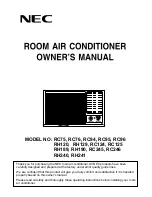
Page 26
507163-01 05/13
UNIT COMPONENTS
High Pressure Switch (S4)
This unit now employs a automatic pressure switch
located on the liquid line of the compressor. The pressure
switch (SPST, auto-reset, normally closed) removes
power form the compressor when liquid pressure rises
above factory setting (opens at 590 + 15 psig and closes at
418 + 15 psig).
Low Pressure Switch (S87)
SSB*H4 units are also equipped with a low pressure switch
that is located in the vapor line of the compressor. The
switch (SPST, auto-reset, normally closed) removes
power from the compressor when vapor line pressure
drops below factory setting at 40 + 5 psi.
Crankcase Heater Relay (K191)
(G Voltage Units Only)
All 460 volt SSB units require the S40 thermostat to be
wired in series with the 24 volt coil of the K191 relay. The
contacts of the K191 control operation of crankcase heater
HR1. When ambient temperature drops below 50° F, K191
contacts close energizing HR1. When the ambient
temperature rises to 70° F the contacts open
de-energizing HR1.
Crankcase Heater (HR1) and Crankcase Thermostat
(S40)
The reference models are equipped with a 70 watt, belly
band type crankcase heater. HR1 prevents liquid from
accumulating in the compressor. HR1 is controlled by a
thermostat located on the liquid line. When liquid line
temperature drops below 50° F the thermostat closes
energizing HR1. The thermostat will open, de-energizing
HR1 once liquid line temperature reaches 70° F .
Internal Solenoid (L34)
The internal unloader solenoid controls the two-stage
operation of the compressor by shifting a slide ring
mechanism to open two by-pass ports in the first
compression pocket of the scrolls in the compressor. The
internal solenoid is activated by a 24 volt direct current
solenoid coil. The coil power requires 20VAC. The internal
wires from the solenoid in the compressor are routed to a 2
pin fusite connection on the side of the compressor shell.
The external electrical connection is made to the
compressor with a molded plug assembly. This plug
contains a full wave rectifier that converts 24 volt AC into
24 volt DC power to power the unloader solenoid. Refer to
unit diagram for internal circuitry view of plug).
Liquid Line Bi-Flow Filter Drier
The unit is equipped with a large-capacity biflow filter drier
which keeps the system clean and dry. If replacement is
necessary, order another of like design and capacity. The
replacement filter drier must be suitable for use with
HFC-410A refrigerant.
Maintenance
DEALER
Maintenance and service must be performed by a qualified
installer or service agency. At the beginning of each
cooling season, the system should be checked as follows:
Outdoor Unit
1. Clean and inspect the outdoor coil. The coil may be
flushed with a water hose. Ensure the power is turned
off before you clean the coil.
2. Outdoor fan motor is prelubricated and sealed. No
further lubrication is needed.
3. Visually inspect connecting lines and coils for
evidence of oil leaks.
4. Check wiring for loose connections.
5. Check for correct voltage at the unit (with the unit
operating).
6. Check amp-draw outdoor fan motor.
UNIT NAMEPLATE: _________ ACTUAL: __________
NOTE - If owner reports insufficient cooling, the unit should
be gauged and refrigerant charge checked.
Outdoor Coil
It may be necessary to flush the outdoor coil more
frequently if it is exposed to substances which are
corrosive or which block airflow across the coil (e.g., pet
urine, cottonwood seeds, fertilizers, fluids that may
contain high levels of corrosive chemicals such as salts)
Outdoor Coil — The outdoor coil may be flushed with
a water hose.
Outdoor Coil (Sea Coast) — Moist air in ocean
locations can carry salt, which is corrosive to most
metal. Units that are located near the ocean require
frequent inspections and maintenance. These
inspections will determine the necessary need to wash
the unit including the outdoor coil. Consult your
installing contractor for proper intervals/procedures
for your geographic area or service contract.
INDOOR UNIT
1. Clean or change filters.
2. Adjust blower speed for cooling. Measure the pressure
drop over the coil to determine the correct blower CFM.
Refer to the unit information service manual for pressure
drop tables and procedure.
3. Check blower drive belt for wear and proper tension.
4. Check all wiring for loose connections
5. Check for correct voltage at unit (blower operating).
6. Check amp-draw on blower motor.
UNIT NAMEPLATE: _________ ACTUAL: __________
INDOOR COIL
1. Clean coil, if necessary.
2. Check connecting lines and coils for signs of oil leaks.
3. Check condensate line and clean, if necessary.
OWNER
Cleaning of the outdoor unit's coil should be performed by
a trained service technician. Contact your dealer and set
up a schedule (preferably twice a year, but at least once a
year) to inspect and service your outdoor unit. The
following maintenance may be performed by the
homeowner.



































